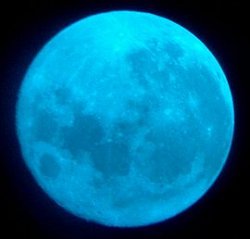In July 2004 we will see two full moons, and this means that one of them will be blue. Will it really be blue? Believe it or not, scientists say, blue moons are not fiction
By: Dr. Tony Phillips, NASA

Blue Moon - Costian Iptica photographed the moon on July 2 using a blue filter.
When we hear someone say "once in a blue moon..." we know that they mean a rare event, that doesn't happen often, maybe even ridiculous. After all, when was the last time you saw a blue moon?
You should look at the night sky on July 31, because there is going to be a blue moon.
According to modern folklore, a blue moon is the second full moon that appears in one month. For the most part, a full moon only appears once during the month, but every once in a while another full moon sneaks up. Full moons appear 29 days apart, while most months are 30 or 31 days long, so you can have two full moons in one month. This event occurs every two and a half years on average.
In July, a full moon already appeared on the 2nd of the month. The next full moon, which will appear on July 31st, is a blue moon by definition.
Will it really be blue? Apparently the answer is negative. The moon does not care what the date is, its color does not change accordingly. The moon on July 31st will be pearly gray as usual. But if…
Not long ago people would see blue moons almost every month. Full moons, half moons, banana moons - they were all blue, except for a few days when they looked green.
That time was 1883, the year an Indonesian volcano called Krakatoa erupted. Scientists compared the explosion to a 100 megaton nuclear bomb. People within a radius of 600 kilometers heard the noise of the explosion as if it was a cannon shot. Clouds of ash flew to the edge of the Earth's atmosphere, and the moon turned blue.
The reason for this is the ash of the Krakatoa. Some of the dust clouds were composed of particles about a micron (millionth of a meter) in size - exactly the size that scatters red light but allows the other colors to pass through. White light from the moon, passing through the dust clouds, appears blue and sometimes green.
Blue moons sometimes remain for years after the volcanic eruption. People also saw oval suns, and for the first time, clouds that glowed in the dark. The dust caused "red sunsets so full of color that firefighters were called in in New York, Poughkeepsie and New Haven to put out what appeared to be fires," said Scott Rowland, a volcanologist at the University of Hawaii.
Other, less powerful volcanic eruptions have also turned the moon blue. People saw blue moons in 1983, for example, after the eruption of the El Chichon volcano in Mexico. There have also been reports of blue moons, caused by the mountains St. Helens in 1980 and Pintobo in 1991.
In order to have a blue moon, it is necessary to have many particles in the air, which are somewhat wider than the wavelength of red light (0.7 microns), and that there should be no other growing particles. This situation is rare, but volcanoes sometimes emit such clouds, and like them also forest fires.
"On September 23, 1950, several hidden fires in wetlands in Alberta suddenly erupted into a huge fire that emitted a lot of smoke," writes University of Alaska physics professor Sue Ann Bowling. "The winds that carried the smoke east and west at enormous speed and the conditions of the fire together created large amounts of oily droplets of just the right size (1 micron), which scattered red and yellow light. Where the smoke had dissipated enough for the sun to be seen, it appeared purple or blue. Ontario and most of the East Coast of the United States were affected by these events, but the smoke continued to advance. Two days later, observers in England reported a dark blue sun against a dusty sky, followed by an equally blue moon.”
There will be wildfires burning in the western United States on July 31st. If one of these fires produces dust or oily smoke, containing many particles as small as 1 micron, the blue moon may really be blue.
There is a higher probability that it will be red. Dust clouds, thrown into the atmosphere by fires and storms, usually contain a mixture of particles of different sizes. Most of them are smaller than 1 micron in size, and they tend to emit blue light. Such clouds cause the moon to turn red. If so, red blue moons are much more common than blue moons that are blue.
ridiculous? Yes, but the whole blue moon thing revolves around the absurdity. Go outside at sunset on July 31st and see for yourself.
Translation: Dikla Oren

4 תגובות
Is the blue moon real or a myth?
Is the blue moon really real or is it air pollution
There was no more grace
When were the eruptions of volcanoes in Israel?